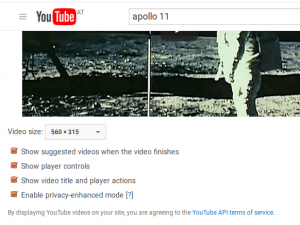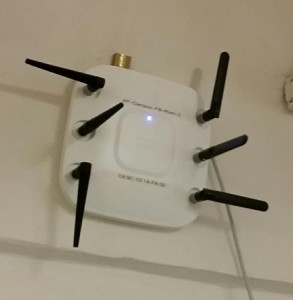 A thing I was not aware about embedding Youtube videos so far was that even when visitors do not click on the video, they are already tracked by Google. Visiting the page in which the video is embedded is enough to get tracked. But it doesn’t have to be that way as there’s a “privacy enhanced” way to embed Youtube videos.
A thing I was not aware about embedding Youtube videos so far was that even when visitors do not click on the video, they are already tracked by Google. Visiting the page in which the video is embedded is enough to get tracked. But it doesn’t have to be that way as there’s a “privacy enhanced” way to embed Youtube videos.
Author: Martin
The DIY Retro Game Console Revisited
 Back in December I returned from 32C3 with a DIY retro game console kit created by Voja Antonic as it promised to be fun to assemble and to study the source code. To me it was “the” hardware discovery of the congress! Apart from the prospect of playing a retro-game and to feel transported back into the 1980’s I was intrigued by the fact that the VGA graphics is not generated by a dedicated graphics unit but is instead done in software on the PIC CPU with three digital outputs that are connected to the red/green/blue lines of the VGA connector and two additional digital outputs to drive the horizontal and vertical synchronization signals for the screen. In other words, a perfect platform to get a hands-on practical view of how bits in memory can be transformed to a colorful picture on the screen.
Back in December I returned from 32C3 with a DIY retro game console kit created by Voja Antonic as it promised to be fun to assemble and to study the source code. To me it was “the” hardware discovery of the congress! Apart from the prospect of playing a retro-game and to feel transported back into the 1980’s I was intrigued by the fact that the VGA graphics is not generated by a dedicated graphics unit but is instead done in software on the PIC CPU with three digital outputs that are connected to the red/green/blue lines of the VGA connector and two additional digital outputs to drive the horizontal and vertical synchronization signals for the screen. In other words, a perfect platform to get a hands-on practical view of how bits in memory can be transformed to a colorful picture on the screen.
320 MHz of Wifi In Univiersity of Vienna’s Main Reading Hall
 When I recently configured a computer for Eduroam access in Vienna I took the opportunity to have a quick look at what’s in the air in Vienna University’s main reading room. It turned out that it was much more than I thought. In short, they use pretty much ALL available spectrum in the 2.4 and 5 GHz bands:
When I recently configured a computer for Eduroam access in Vienna I took the opportunity to have a quick look at what’s in the air in Vienna University’s main reading room. It turned out that it was much more than I thought. In short, they use pretty much ALL available spectrum in the 2.4 and 5 GHz bands:
Continue reading 320 MHz of Wifi In Univiersity of Vienna’s Main Reading Hall
Removing Google Fonts On This Blog
I was more than a bit annoyed when I noticed that whenever I restart the browser and load my website, the browser reaches out to Google to load a number of font files. What!?
Book Review – The Billion Dollar Heist
 Good techno-thrillers with realistic plots and technical details are hard to come by and it seems they are mainly coming from what I would call “alternative authors” these days. Case in point are Chronos by William Hern, The Martian by Andy Weir and books by Mark Russinovich like Rouge Code that I’ve reviewed and recommended in the past. Here’s another one “The One Billion Dollar Heist” by Ben Lovejoy!
Good techno-thrillers with realistic plots and technical details are hard to come by and it seems they are mainly coming from what I would call “alternative authors” these days. Case in point are Chronos by William Hern, The Martian by Andy Weir and books by Mark Russinovich like Rouge Code that I’ve reviewed and recommended in the past. Here’s another one “The One Billion Dollar Heist” by Ben Lovejoy!
A Busch 2090 Emulator on an Arduino
Over the past years I’ve explored many ways how to combine my memories of computing of the 1980’s with my quest to better understand how a CPU works and using contemporary technology for the purpose. Here’s another cool approach to do this by emulating a Busch 2090 4-bit computer on an Arudino.
Uninstalling Wine – Bye Bye Windows Emulation Layer
It’s been a while since I switched the final Windows based machine to Linux at my place. Admittedly there are a few things I still need Windows for but those can comfortably run in a Virtual machine on a Linux host or by using Wine, the Windows Emulation Layer for Linux. But time has come to go a step further once again.
Continue reading Uninstalling Wine – Bye Bye Windows Emulation Layer
Eduroam – Wifi With A Certificate And Cool Roaming Features
 Back in December 2015 I found my first public Wifi network at 32C3 that used a certificate instead of a common password, not so much for user authentication but for assigning an individual ciphering key to each device. Especially at a hacker conference that’s a plus as normal WPA encryption uses the same passphrase for everyone and hence attackers can decrypt the Wifi traffic of others if they know the common passphrase and have intercepted the authentication dialog. When recently being asked to configure a computer for Eduroam access, an international Wifi network at universities (for a world map see here), I found yet another flavor of Wifi certificate use that is highly interesting.
Back in December 2015 I found my first public Wifi network at 32C3 that used a certificate instead of a common password, not so much for user authentication but for assigning an individual ciphering key to each device. Especially at a hacker conference that’s a plus as normal WPA encryption uses the same passphrase for everyone and hence attackers can decrypt the Wifi traffic of others if they know the common passphrase and have intercepted the authentication dialog. When recently being asked to configure a computer for Eduroam access, an international Wifi network at universities (for a world map see here), I found yet another flavor of Wifi certificate use that is highly interesting.
Continue reading Eduroam – Wifi With A Certificate And Cool Roaming Features
Bad Internet Connectivity Makes Me Leave The Turkish Airlines Lounge
The Turkish Airlines Lounge in Istanbul is by all means one of the coolest places to stay at any airport around the globe. Well at least it was so far. Apart from a nice interior one thing that is obviously absolutely crucial to me and many other business travelers is good Internet connectivity. And this is more and more difficult to get in that lounge.
While there is Wi-Fi in the lounge, OpenVPN and IPSec connectivity is blocked. No idea why but I’m probably not the only business traveler who is more than unhappy about this. At least I can use an SSH tunnel VPN that they (forgot?) to block to get my data safely through the network. Another option that has worked so far in the lounge is to tether my PC via a mobile device and one of the cellular networks there to the Internet. Unfortunately both times I’ve been there recently, Turkcell and Vodafone Turkey failed miserably.
Outside the lounge at the gates, both networks worked well so I decided to leave. Perhaps one of the companies involved in this cares and does something about the situation next time. Would be nice…
In-Flight Internet Reloaded On A Flight To Asia
 Back in 2011 I had my first in-flight Internet experience over the Atlantic with a satellite based system. Since then I’ve been online a couple of times during national flights in the US where a ground based system is used. In Europe most carriers don’t offer in-flight Internet access so far but an LTE based ground system is in the making which will hopefully have enough bandwidth so support the demand in the years to come. When I was recently flying to Asia I was positively surprised that Turkish Airlines offered Internet access on my outbound and inbound trips. Free in business class and available for $15 for the duration of the trip in economy class I was of course interested of how well it would work despite both flights being night flights and a strong urge to sleep
Back in 2011 I had my first in-flight Internet experience over the Atlantic with a satellite based system. Since then I’ve been online a couple of times during national flights in the US where a ground based system is used. In Europe most carriers don’t offer in-flight Internet access so far but an LTE based ground system is in the making which will hopefully have enough bandwidth so support the demand in the years to come. When I was recently flying to Asia I was positively surprised that Turkish Airlines offered Internet access on my outbound and inbound trips. Free in business class and available for $15 for the duration of the trip in economy class I was of course interested of how well it would work despite both flights being night flights and a strong urge to sleep
While most people where still awake in the plane, speeds were quite slow. Things got a bit better once people started to doze off and I could observe data rates in the downlink direction between 1 and 2 Mbit/s. Still, web browsing felt quite slow due to the 1000 ms round trip delay times over a geostationary satellite. But it worked and I could even do some system administration over ssh connections although at such round trip times command line interaction was far from snappy.
In the uplink I could get data rates of around 50 to 100 kbit/s during my outbound leg which made it pretty much impossible to send anything larger than a few kilobytes. On the return trip I could get around 300 kbit/s in the uplink direction when I tried. Still not fast but much more usable.
Apart from web browsing and some system administration over ssh, I mostly used the available connectivity to chat and exchange pictures with others at home using Conversations. While being mostly available, I noticed a number of outages in the link ranging from a few tens of seconds to several minutes. I’m not sure by what they were cause surely not due to clouds or bad weather above the plane… 🙂
While overall I was happy to be connected I have to say that like in the US, this system is not offering enough capacity anymore and it will become more and more difficult to offer a good customer experience without bumping up speeds significantly.